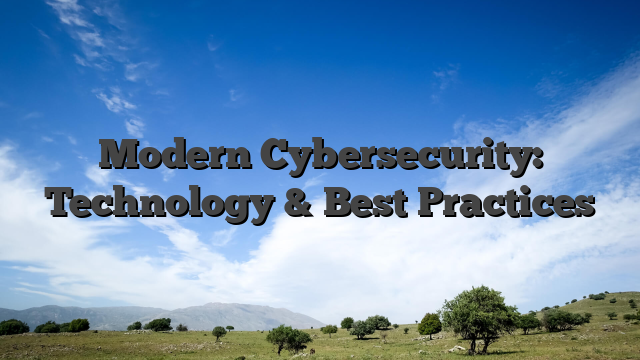Introduction to Modern Cybersecurity
In our increasingly digital world, the significance of cybersecurity cannot be overstated. The rapid advancements in technology have brought unparalleled convenience but have also opened the floodgates to a myriad of cyber threats. Ensuring robust cybersecurity measures has become a cornerstone in protecting sensitive information, data, and systems from malicious actors.
Cyber threats are constantly evolving, becoming more sophisticated and diverse. From ransomware attacks to phishing schemes and data breaches, organizations and individuals alike are vulnerable to an array of risks in the digital space. Consequently, understanding modern cybersecurity practices is critical in safeguarding against these threats.
Technological Aspects of Modern Cybersecurity
Encryption and its Role
Encryption serves as the cornerstone of cybersecurity, ensuring the confidentiality and integrity of data. It transforms plain, readable information into a scrambled format, making it unreadable to unauthorized individuals. Advanced Encryption Standard (AES) is commonly employed to secure data at rest and in transit, providing a robust defense against potential breaches. Encryption techniques are utilized in various areas, such as securing communications (like email and messaging), protecting sensitive files, and ensuring secure transactions across networks.
Firewalls and Network Security
Firewalls are critical components of network security, acting as a protective barrier between a trusted internal network and untrusted external networks. These barriers filter incoming and outgoing traffic based on predefined security rules. They prevent unauthorized access, thwart potential cyber threats, and help monitor network traffic for suspicious activities. Firewalls can be hardware-based, software-based, or a combination of both, effectively shielding against a wide array of threats, including malware and unauthorized access attempts.
Intrusion Detection Systems (IDS) and Intrusion Prevention Systems (IPS)
Intrusion Detection Systems (IDS) and Intrusion Prevention Systems (IPS) are crucial in the battle against cyber threats. IDS continually monitors network traffic, identifying potential security breaches or irregular activities. It generates alerts when suspicious behavior is detected. IPS, on the other hand, not only identifies potential threats but also takes proactive measures to prevent or block these threats. It functions by analyzing and responding to identified threats in real-time. Both systems are vital in fortifying network security and preventing unauthorized access or cyberattacks.
Endpoint Security and Anti-Malware Solutions
Endpoint security focuses on protecting individual devices connected to a network, such as computers, mobile devices, or IoT devices. These devices often serve as entry points for cyber threats. Endpoint security solutions include anti-malware software, firewalls, and intrusion prevention systems specifically designed for individual devices. Anti-malware solutions detect, prevent, and remove malicious software, safeguarding against various types of malware, including viruses, ransomware, and spyware.
Secure Authentication Methods (Multi-factor Authentication)
Multi-factor authentication (MFA) offers an additional layer of security beyond the traditional username and password approach. It requires users to provide multiple forms of identification before granting access, typically something the user knows (password), something the user has (smartphone or token), and/or something the user is (biometric verification). MFA significantly enhances security by reducing the risk of unauthorized access, even if login credentials are compromised.
Read more – Software Development in Singapore
Best Practices in Modern Cybersecurity
- Employee Training and Awareness Educating employees about cybersecurity risks and best practices is crucial. Human error is often a significant factor in cyber incidents. Regular training programs can empower employees to recognize and mitigate potential threats.
- Regular Software Updates and Patch Management Software updates and patches often contain crucial security enhancements. Regularly updating systems and applications is imperative to shield against known vulnerabilities exploited by cyber attackers.
- Data Backup and Recovery Strategies Having a robust data backup plan is essential in the event of a cyber incident or system failure. Regularly backing up data and implementing reliable recovery strategies can minimize the impact of potential data breaches.
- Secure Configuration and Access Control Maintaining secure configurations for hardware and software is vital. Limiting access privileges to only necessary personnel reduces the risk of unauthorized access.
- Incident Response and Disaster Recovery Plans Preparing and testing incident response and disaster recovery plans can mitigate the impact of a security breach. Swift and efficient response measures can contain and resolve security incidents effectively.
Emerging Technologies and Trends in Cybersecurity
- Artificial Intelligence (AI) and Machine Learning AI and machine learning play pivotal roles in cybersecurity. These technologies enhance threat detection and response by analyzing vast amounts of data to identify patterns and anomalies, enabling more proactive and efficient security measures.
- Blockchain Technology for Security Blockchain technology offers decentralized and immutable data storage, ensuring greater security and transparency. Its use in areas like secure transactions and data integrity has the potential to revolutionize cybersecurity.
- Internet of Things (IoT) and Security Concerns The proliferation of IoT devices brings new security challenges. Securing interconnected devices and networks is essential to prevent vulnerabilities that could be exploited by cybercriminals.
- Cloud Security and Solutions As businesses increasingly rely on cloud services, robust cloud security measures are imperative. Implementing encryption, strict access controls, and monitoring tools ensure data security in cloud environments.
- Quantum Computing and its Impact on Security While quantum computing offers significant advancements, it also poses a potential threat to current encryption methods. Preparing for quantum-resistant encryption is becoming crucial to safeguard sensitive data.
Challenges in Modern Cybersecurity
- Advanced Persistent Threats (APTs) APTs are sophisticated, long-term cyberattacks designed to breach systems discreetly. Detecting and mitigating these threats require constant vigilance and advanced security measures.
- Insider Threats and Human Error Insider threats, whether intentional or unintentional, pose a substantial risk. Employee training and stringent access controls are vital in mitigating these threats.
- Regulatory Compliance and Data Protection Laws Navigating and complying with diverse data protection regulations and privacy laws presents a challenge for businesses, particularly in an increasingly global and interconnected digital environment.
- Cybersecurity Skills Gap The shortage of cybersecurity professionals poses a significant challenge. Bridging this gap through education and skill development is crucial in ensuring sufficient protection against cyber threats.
- Privacy Concerns in a Connected World As connectivity increases, concerns over data privacy and protection also rise. Striking a balance between technological advancement and maintaining privacy is a pressing challenge.
Read More – Software Development Services in Singapore
Future Outlook and Conclusion
The future of cybersecurity will continue to evolve as technology advances. Adapting to new threats, embracing emerging technologies, and prioritizing data protection will be pivotal for organizations. Cybersecurity will remain an ever-evolving field, requiring constant innovation and adaptation to safeguard digital assets and privacy.
In conclusion, the rapidly evolving cyber threat landscape demands a holistic and multi-faceted approach to modern cybersecurity. Understanding the significance of technological advancements, addressing emerging challenges, and anticipating future trends will be crucial in ensuring robust cybersecurity measures for individuals and organizations.




